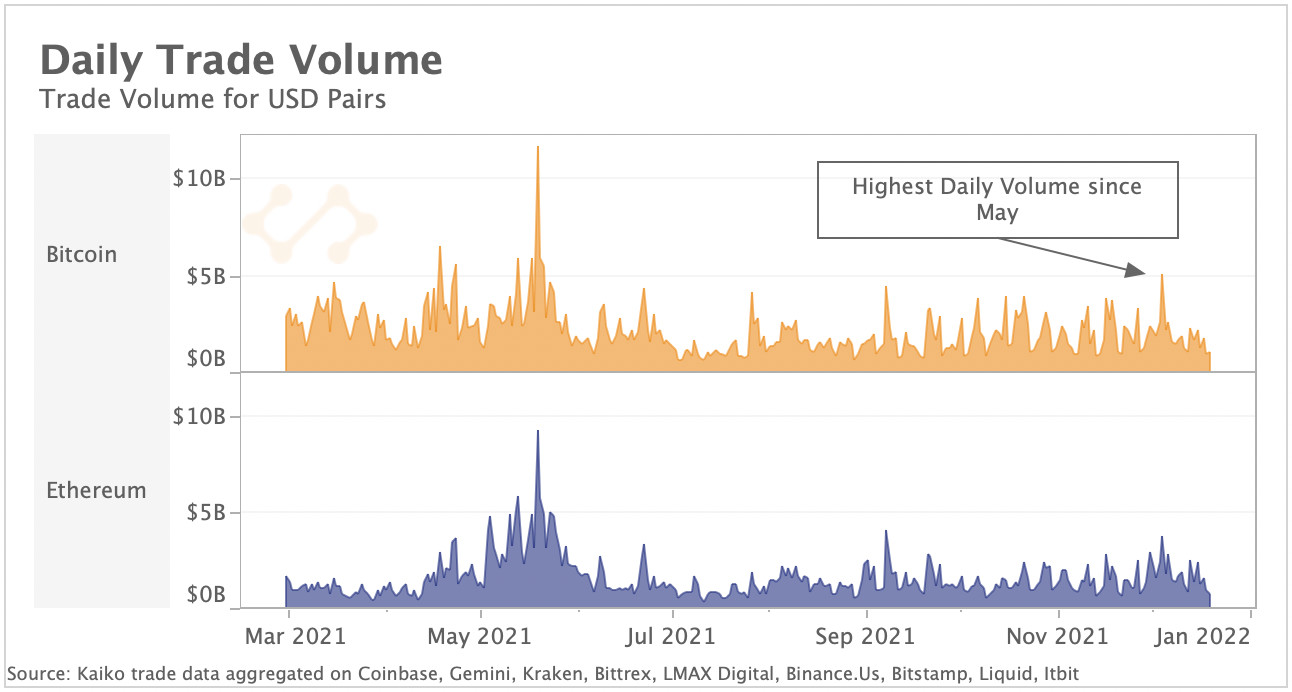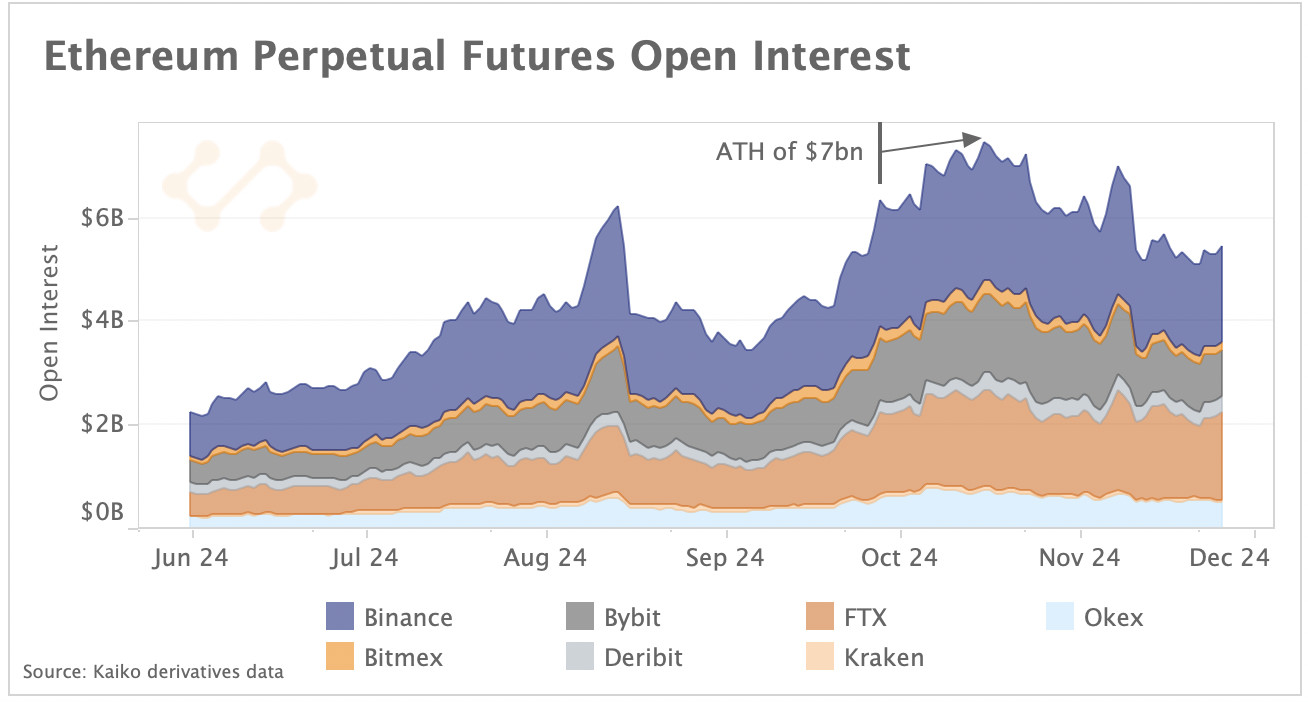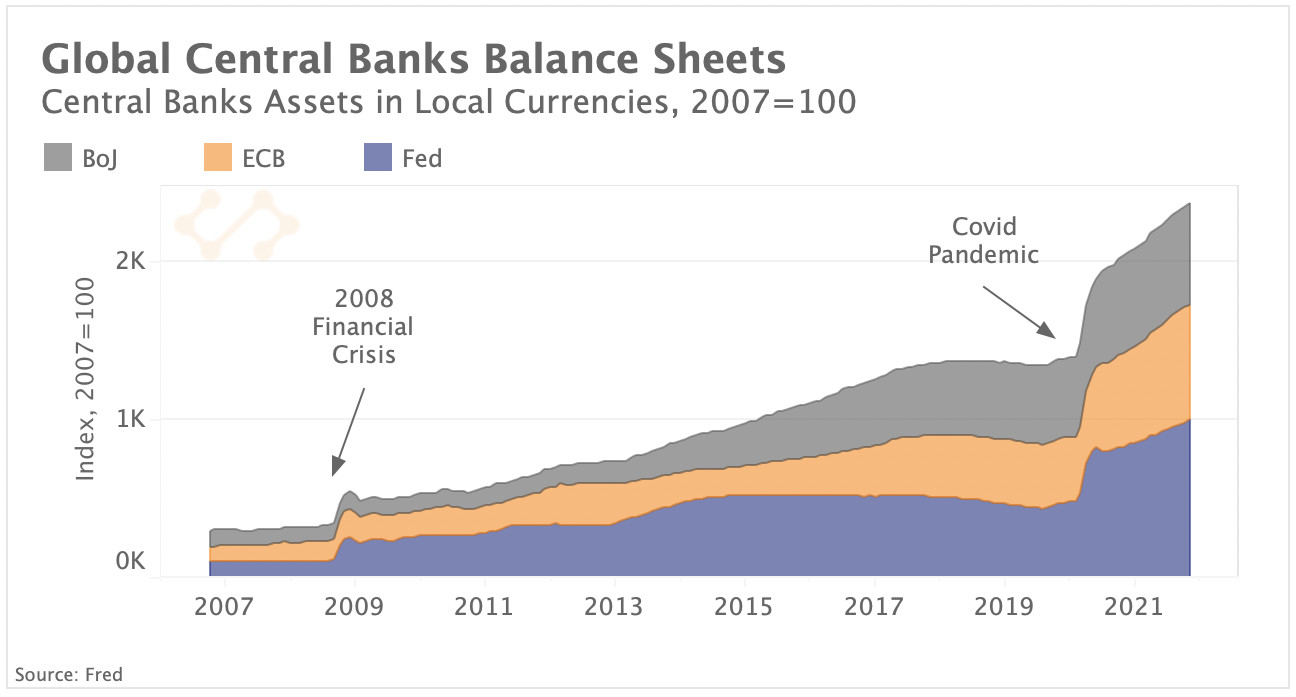A summarizing review of what has been happening at the crypto markets of the past week. A look at trending sectors, liquidity, volatility, spreads and more. The weekly report in cooperation with market data provider Kaiko.
The last 7 days in cryptocurrency markets:
- Price Movements: DeFi tokens have strongly underperformed ETH throughout 2021.
- Volume Dynamics: Bitcoin-Lira trade volume approached all time highs following Turkey's historic currency crisis.
- Order Book Liquidity: Altcoin bid-ask spreads remain significantly wider than BTC/ETH spreads.
- Derivatives: Ethereum open interest has fallen sharply over the past month, but is still more than double July's levels.
- Macro Trends: Global central banks have begun dialing back stimulus measures, creating financial market jitters.
December sell-off continues

Fear continues to grip markets as we enter the third week of December, with BTC down 20% and ETH down 17% since the start of the month. Both crypto and equity markets briefly bounced last week following the Fed’s announcement that it will accelerate the pace of tapering amid rising inflation. However, the rebound didn’t last long, with markets pulling back sharply early Monday morning.
Last week, the Bitcoin network reached a milestone of 90% of all BTC supply mined right as the hashrate broke a new all time high. In other news, NYDIG raised a whopping $1 billion and blockchain analytics startup Nansen closed an early-stage $75m round.
DeFi markets underperform
DeFi tokens have lost significant gains since highs reached in May, and are consistently underperforming Ethereum since October. While most tokens are still well in-the-green since January 2021, they have failed to maintain momentum. Synthetix (SNX) has been the worst performer, registering negative YTD returns of -34% as of mid-December. Maker (MKR) and decentralized exchange Uniswap’s governance token UNI are this year’s best performers, up by 313% and 209% respectively. The stagnant returns come as the industry struggles with a series of high-profile hacks over the past few months and rising Ethereum transaction fees. Despite persistent scalability concerns, Ethereum is one of the year's best performers, up 431% YTD.
BTC-TRY trade volume approaches all time highs amid Lira’s meltdown
Trade volume for the BTC-TRY currency pair is spiking following a historic depreciation of Turkey's currency (TRY). Despite Turkey banning the use of crypto for payments in April, crypto adoption is again gaining traction in the country. The TRY crashed to historical lows last week nearing 17 lira against the U.S. Dollar. Despite inflation running at 21% in November, the central bank pursued an ultra-loose monetary policy cutting its key policy rate by 100bps last week. This contributed to a sell-off in equities, with the Borsa Istanbul forced to halt trading twice on Friday. According to on-chain data from Chainalysis, crypto adoption in Turkey is among the highest in the Middle east region. Overall, weekly trade volumes have grown significantly since 2020 from a few million to over 4bn (lira).
Trade volumes remain flat
The market-wide sell-off that has persisted since early December resulted in a temporary spike in Bitcoin and Ethereum trade volumes. However, despite the increase, volumes still remain consistently below their levels from earlier this year, hovering between $1-$3B as strong volatility and bearish sentiment keeps traders off the market. Daily volumes hit a historical high on May 19th but have mostly stayed flat since, despite both Bitcoin and Ethereum hitting an all-time high in October and November. This suggests that early Fall's bullish price movements lacked conviction.
Ethereum open interest is down but remains near all time highs
Ethereum open interest has increased steadily over the past few months despite retreating from November all-time highs. The trend suggests a growing interest for altcoin derivatives. Above we chart Ethereum open interest on seven exchanges and we observe it has more than doubled since July to around $5bn currently. Both Bitcoin and Ethereum open interest declined in December after a sell-off in traditional markets spilled into crypto, triggering massive deleveraging on crypto derivative markets. However, Bitcoin perpetual futures open interest struggled to recover and currently hovers around its end-of-September levels of $9b, down 40% from its November highs. ETH open contracts showed more resilience and remained well above September lows. Funding rates, which are seen as a gauge of overall market sentiment and leverage, are neutral as traders are cautious to take new risks ahead of the end-year holiday season.
Global monetary policy jitters spur volatility
Both crypto and traditional markets whipsawed last week on global rate hikes jitters following several key central bank meetings. Despite uncertainty around the Omicron variant, the U.S. Fed confirmed its hawkish shift, doubling the rate of tapering of its monthly bond purchases to $30bn per month and signaling the prospect of three rate hikes in 2022. The European Central Bank (ECB) and the Bank of Japan (BoJ) remained more cautious despite also announcing that they will gradually start dialing back stimulus.
With inflation running hot and the new Omicron Covid variant weighing on growth, central banks are caught between a rock and a hard place. Lifting rates too quickly could jeopardize the recovery while failing to act could mean falling behind the curve in inflation fighting. The extraordinary monetary policy stimulus adopted at the start of the pandemic has resulted in an unprecedented expansion of global central banks balance sheets which are currently at historical highs (charted above). Both the U.S. Fed and the ECB assets have more than doubled while BoJ’s assets reached 1.3 times the size of the country’s economy.
Typically, the tightening of financial conditions is expected to negatively impact risk assets such as tech stocks and crypto which become less attractive than safe-haven bonds. However, real yields (after inflation is taken into account) are expected to remain low for a prolonged period of time as inflation appears stickier than anticipated while the terminal interest rates (or the level where the rate hikes will end) will likely remain lower relative to previous hiking cycles. This could benefit crypto assets as the search for yields will push investors up the risk curve.
Bitcoin moves in line with growth stocks
Despite the rebound in volatility over the past weeks, U.S. equities have had a stellar year with both the S&P 500 and the teach-heavy Nasdaq 100 registering robust profit margins despite soaring inflation. However, market breadth - or the number of stocks participating in the rally - has been steadily narrowing over the past few months which suggests that the current stock market trend is fragile and more vulnerable to sell-offs.
Above, we chart the Russell 1000 Value and Growth Indices along with Bitcoin price, to better understand the sector rotation between stocks. Value stocks are companies that are cheaper and often pay dividends to stakeholders while growth stocks are faster growing, driven by innovation over the long term and more expensive. Typically, financial, healthcare and energy are considered value stocks while growth stocks are mostly tech related. We observe that growth stocks have mostly outperformed over the past few years despite a rebound in value stocks in the first quarter of 2021. Bitcoin, which is still early in its adoption curve, has been moving more in line with growth stocks.










